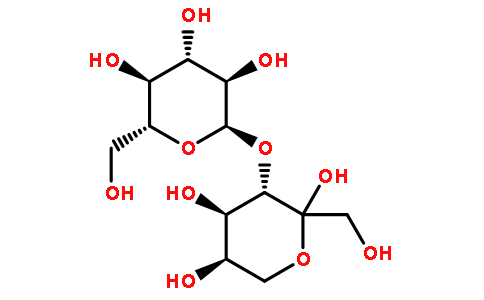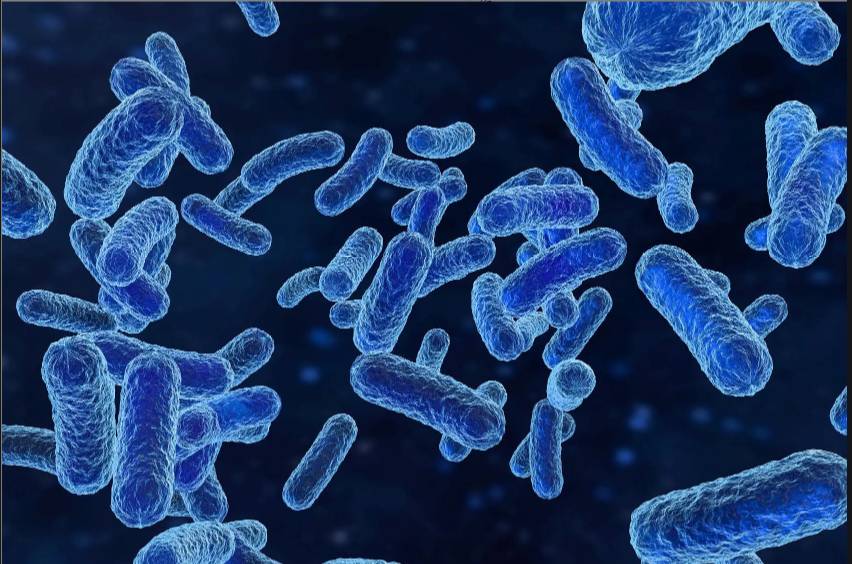食品分野でのタガトース粉末の用途は何ですか?
Tagatose(see Figure 1) is an enantiomer のfructose at the C-4 chiral carbon atom とa molecular weight の180∙16u とCAS 87- 81-0. It is a good low-energy food 甘味料and filler, and has various physiological effects such as inhibiting hyperglycemia, improving intestinal flora, and being non-cariogenic. In 2001, the US FDA approved tagatose as GRAS.

1 .タガトースの性質と機能
Pure tagatose is a white, odorless, non-crystalline substance with a melting point of 134°C and a glass transition temperature of 15°C. It is highly water-soluble and, when dissolved でwater, causes the boiling point to rise and the freezing point to fall. However, it does not absorb heat, so it does not produce a cooling effect. Tagatose is hygroscopic and has good stability under acidic conditions. It can exist stably in the pH range of 3–7. It is prone to Maillard browning and can caramelize at lower temperatures [1].
タガトースはショ糖の92%の甘さで、甘味料としても優れています。その甘さの特徴はスクロースに似ており、不快なオフフレーバーや後味はありません。比較的、タガトースの甘さはスクロースよりも早く刺激され、フルクトースに似ている。また、シクラミン、サッカリン、アスパルテーム、アセスルファム、ステビア、ネオテーム、スクラロースなどの強力な甘味料との良好な相乗効果があります[2]。
The tagatose ingested によってthe body is not completely absorbed by the small intestine. The tagatose absorbed by the small intestine is metabolized via the liver via the glycolytic pathway. Unabsorbed tagatose enters the large intestine directly, where it is almost completely fermented by the microbial flora. The short-chain fatty acids produced by this fermentation are almost completely reabsorbed and metabolized by the body. Based on many relevant studies, the US FDA has confirmed that tagatose can be labeled with an energy value of 6280∙2J/g on nutrition labels [1].
タガトースは自然界に広く存在し、いくつかの食品(殺菌牛乳、uht (ultra high temperature:超高温殺菌)牛乳、粉ミルク、ホットココア、各種チーズ、ヨーグルト、乳児用粉ミルクなど)およびいくつかの植物や医薬品に含まれています[3]。
体内の吸収率が低く、血糖値を大きく変化させないため、糖尿病患者に適している。研究によると、健康な被験者および2型糖尿病患者において、タガトースは空腹時血糖値およびインスリン値に有意な変化を引き起こさず、糖尿病患者におけるグルコース摂取による血糖値の増加を有意に抑制することができる[4]が、インスリン感受性に有意な影響を及ぼさないことが示されている。また、糖尿病の症状を緩和・改善し、さまざまな合併症の発生を抑制することが特許で報告されています[5]。タガトースが高血糖を抑制するメカニズムは、低吸収率に加えて小腸でのグルコースの吸収を抑制することと考えられる。
Only 20% of the tagatose ingested by the body is absorbed by the small intestine. The vast majority of tagatose enters the colon directly, where it is selectively fermented by the microbial flora, promoting the growth of beneficial bacteria and inhibiting the growth of harmful bacteria, which has a significant effect on improving the intestinal flora and is a good prebiotic [6]. At the same time, the fermentation of tagatose also produces a large amount of beneficial short chain fatty acids (SCFA). In particular, butyric acid is a good energy source for colon epithelial cells and is considered to have a good effect in inhibiting colon cancer, inhibiting intestinal pathogenic bacteria (such as Escherichia coli, etc.) and promoting the growth of beneficial bacteria such as lactic acid bacteria. Some studies have found that the minimum dosage of tagatose to have a significant prebiotic effect is 7.5 g/d.
研究によると、タガトースは歯垢のphを低下させず、虫歯を引き起こさないことが示されています[1]。歯垢の抑制と口臭の除去に効果があるため、虫歯、歯肉炎などの歯の病気の抑制、口臭の除去、歯の清掃などに広く使われている。2002年12月2日、アメリカ食品医薬品局(fda)は多くの科学的研究の結果に基づき、タガトースは口腔内細菌によって発酵されておらず、虫歯を引き起こさないことを確認する声明を発表した。
他の研究では、健康な患者や2型糖尿病患者において、タガトースが適切かつ継続的に体重を減らすことができることが示されています[1]。特許報告によると、,タガトースはまた、血液の健康を促進するために非常に有益です[7]そして、女性ラットの妊娠の可能性を高め、母体と胚の健康を促進することができます[8]。さらに、タガトースは毒素に対する細胞の感受性を高め、コカイン、ニトロフラントインなどの肝細胞に対する毒性作用を有意に阻害することもできる[9]。
A large number of safety and toxicology tests have shown that tagatose is safe and non-toxic. On April 11, 2001, the US FDA approved tagatose as GRAS for use in food. Later, Australia and New Zealand also approved the use of tagatose in food。しかし、タガトースの過剰な消費はまだ、鼓腸や下痢などの軽度の胃腸不快感を引き起こす可能性があります#39;sのタガトースの吸収障害。2001年6月、fao / who合同食品添加物専門家委員会(jecfa)は、adiが0 - 80 mg/kg・dの食品添加物としてタガトースを承認した[1]。
2タガトースの製造技術
タガトースは一般的にガラクトースから化学的または酵素的異性化によって生産される。ガラクトースはラクトースを加水分解することで得られる。いくつかの研究では、ガラチトールを原料として利用し、生物学的に酸化してタガトースを生成する。しかし、ガラクチトールは比較的高価であり、現時点では工業生産には適していません。
2.1タガトースの化学合成
タガトースの化学合成はガラクトースを原料とし、主に異性化と酸中和の2段階からなる[10]。まず、可溶性アルカリ金属塩またはアルカリ土類金属塩を触媒として用い、ガラクトースを水酸化金属と異性化して金属水酸化タガトース錯体中間体を形成する。中間体は酸で中和され、最終生成物であるタガトースが得られる。ガラクトースはラクトースを加水分解することで得られる。
ガラクトースの異性化は、タガトースの化学合成における重要なステップである。コスト上の理由から、金属水酸化物反応物はca (oh) 2またはca (oh) 2とnaohの混合物が好ましい。一般的には、ca (oh)2を水に混合した水溶性スラリー、または水に混合した石灰(cao)を加えた水和物として添加される。アルカリ金属塩(またはアルカリ土類金属塩)の触媒は通常cacl2で、使用量はガラクトースのモル数の約1 ~ 5%です。異性化反応は、アルカリおよび低温条件下で行われるべきです,phの範囲内で制御>10と-15 ~ 40°c。
酸性中和の目的は、不溶性の金属塩を形成し、複雑な中間体からタガトースを放出することである。残りのイオンはイオン交換樹脂によって除去されます。酸の中和にはh2so4、h3po4、hclが使用でき、co2が最適です。酸性中和の進行は、反応系のphに応じて制御されます。phが<7になると、中和反応が完了します。
酸の添加中、反応系の温度は、副作用を避けるために25°c以下に制御する必要があります。最後に、反応溶液からタガトースを結晶化し、濾過する。
例えば、230 lのステンレスの反応容器に10・0kgのラクトースと40 lの純水を加えてよく混ぜ、温度を50°cに上げます。ラクターゼを加え、加水分解が基本的に完了するまで6時間加水分解すると、グルコース45%、ガラクトース45%、ラクトース10%を含むラクトース加水分解物が得られます。ラクトース加水分解物を25°cまで冷却した後、154 gのcacl2とca (oh)2水溶液(ca (oh)2 2.0 kg +水2.5 l)を順に加える。適当な10%のnaoh溶液を加えてphを12.5に調整します。3時間反応すると、反応混合物は厚くなり、沈殿し始めます。沈殿物を濾過し、遠心分離機でパスティ・フィルター・ケーキを得る。25 lの水をフィルターケーキと混合して懸濁液を形成する。その後、適切な量のco2を導入し、溶液を中和して最終ph 6.5にしました。中和過程で濾過ケーキが溶解し、最終生成物であるタガトースとcaco3が沈殿した。反応溶液は遠心分離、脱イオン化、結晶化によって精製され、タガトースが得られた。hplc解析では、タガトースの収率は47.6%に達した。
2.2タガトースの酵素合成
研究によるとL-arabinose異性化酵素(araa, ec 5∙3∙1∙4)は類似した立体配座を持つl-アラビノースとd-ガラクトースの異性化触媒活性を持ち、それぞれl-リブロースとd-タガトースを異性化することができる[11,12]。
lactobacillus fermentum、lactobacillus pentosus、lactobacillus mannitopous、lactobacillus buchneri、lactobacillus brevis、lactobacillus pentoaceticus、lactobacillus lycopersiciおよびその他の種のlactobacillus、aerobacter aerogenes、bacillus amyloliquefaciens、bacillus subtilis、candida utilis、(aerobacter aerogenes)、medical 環状桿菌(bacillus amyloliq uefaciens)、bacillus subtilis、candida utilis、clostridium acetobutylic um)、(escherichia 大腸菌),erw inia cativosa,(マイコバクテリウム属),(サルモネラチフィムリウム),(pediococcus, pediococcus pentosaceous) (rthrobacter)は発酵させてaraaを生成する。l-アラビノースを炭素源としてph 5.5 - 7.0および30 - 40°cで発酵させると、l-アラビノース・イソメラーゼという酵素が得られる。

araaの発生源によって、最適な異性化条件は異なります。異性化は通常20 - 80℃、ph 4.0 - 9.0、好ましくは50 - 70℃、ph 5.5 - 7.0で行われる。いくつかの変異株は100℃までの温度で異性化できるl-アラビノースイソメラーゼを産生することもある。ある研究では、thermotoga neapolitanaのaraaコード遺伝子をクローンし、再結合し、大腸菌で発現させることで、非常に高い熱安定性を持つ組み換えaraaを得ることができることが示されている[13]。
d-ガラクトースの濃度は異性化反応の速度と変換速度に大きく影響する。原料のd-ガラクトース濃度が高い場合は、通常、d-ガラクトースからタガトースへの変換のための酵素反応過程のミカエリス定数kmが高いため、収量も高い。原料のd-ガラクトースの濃度が低い場合には、生産する酵素の系統に依存する。
図2は、ラクトース浸透(チーズホエイまたはカウ&の超濾過によって得られる)からのタガトースの調製プロセスフローを示しています#2 ~ 6%の乳糖、0.2% ~ 0.4%のタンパク質、0.2% ~ 0.6%の塩および微量の脂肪を含む39 s牛乳)[14]。乳糖支配で浸透除去されるタンパク質を削除し(1)、そしてを通過する貯蔵タンク(2)はdesalted所に集まる逆浸透(3)してきた。濃縮液microfiltrationを隔てて高分子量物质には古い角質を除去する(4)(細菌、すなわち、不溶性、タンパク質)によって加水分解スナイパー酵素による(5)はブドウ糖と半乳糖ものが入り交じる(ブドウ糖:半乳糖は1:1)。ラクトース加水分解物は半連続的に発酵させ(6)、ブドウ糖を酵母や細菌によって発酵させてエタノールを生成し(15)、真空ポンプによって回収され(16)、蒸留される。あるいは、液体を遠心分離機(7)で無細胞の液体にし、蒸留によりエタノールを回収し(16)、微生物細胞を発酵槽(6)に戻すこともできます。
蒸留によって回収されたエタノールは、副生成物として貯蔵タンク(7)に送り込まれます。未発酵のガラクトースは異性化され(8)、ガラクトースとタガトースの混合物が得られる。のtagatose原油液体次に、カチオン交換カラム(9)を通過させ、脱イオン水(10)を選択的に溶出させることで分離されます。未異性化ガラクトースは再び異性化カラム(8)に戻る。タガトース粗液を蒸発濃縮(11)、結晶化(12)、濾過、乾燥させ、完成品を得る。結晶化過程では、適切な量のエタノールとタガトース種子結晶を導入し、結晶化を促進します。エタノールは濾過・回収され、結晶化槽(12)に戻されてリサイクルされます。
2.3ガラクチトールからタガトースへの生物学的変換
研究によると、酢酸細菌はガラクチトールをタガトースに生変換することができる[15]。研究によると、アセトバクターsp∙は3 - 35 mg/ lの低収率でタガトースを産生し、グルコノバクターsp∙はガラチトールを100 - 160 mg/ lの高収率でタガトースに酸化する。中でもグルコノバクターmim 1000/9は最も収率が高く、5 g/ lのガラチトールを24時間で酸化して158 mg/ lに達する。また、ガラクトースやフルクトースの副生成物も検出されなかった。
タガトースの収率を上げるために、培地中でガラクチトールの添加量を徐々に増やしてg∙oxydans dsmを誘導しました 2343株は徐々にgalactitolの高濃度に適応する。その結果、ガラクチトール脱水素酵素の活性とタガトースの収率が有意に向上した。栽培24時間後の最大収量は3160 mg/ l (20 g/ lガラチトール、24時間)、換算率は6.6×10-3 l /hであった。
3つの用途があります
3.1タガトースの風味向上
Tagatose has a good synergistic sweetening effect on strong sweeteners [1]. A small amount of tagatose can significantly enhance the sweetness. When used in combination with a strong sweetener, it can replace a significant amount of the strong sweetener, and the amount can even be below the sweet taste threshold. 0∙1 to 50g/kg of tagatose can achieve a good synergistic sweetening effect, especially at a dosage of 0∙5 to 20g/kg. The sweetness of tagatose can be greatly enhanced by combining it with a powerful sweetener, and its taste, flavor and aftertaste can be significantly improved.
タガトースは、シクラミン、サッカリン、アスパルテーム、アセスルファム- k、甘草甘味料、ステビア、モンクフルーツエキス、ソーマチン、アリタメ、ネオタメ、スクラロースなど、多くの強力な甘味料に優れた相乗効果を有します。濃厚な甘味料の種類、最終製品の甘さ、官能要件(口当たり、後味、風味)に応じて、タガトースの甘味料に対する質量比は通常1:1から1000:1であり、できれば4:1から200:1の間です[2]。
感覚分析コーラとレモネード酒を饮みシステムでは、加算少量のtagatose規模で製品の食感さを大きく向上させ、苦い余韻を残すを減らす金属後味と渋皮味強甘味料に起因する(しかし、サッカリンacesulfameなど出て、等)、が、の甘み商品を速くを刺激され、実にやり切れない気持ちと力を得た爽やかな食感ですさらに、飲料システム内の可溶性固形分の含有量を増加させることができ、飲料の味をより完全にすることができます。全体的にはtagatose makes the taste and flavor of low-energy light beverages closer to that of full-energy traditional beverages sweetened with sucrose.

濃厚な甘味料(チョコレート味、ヨーグルト味、フルーツ味など)を加えた低脂肪乳飲料には、タガトースを添加すると味が大幅に改善され、濃厚な甘味料による後味の苦味が軽減され、最高の甘さと後味が得られる。特にチョコレートミルクドリンクの場合、タガトースは濃厚でまろやかなクリーミーな風味を大幅に向上させることができます。
さらに、タガトースは菓子やチョコレート製品に適した風味向上剤でもあります。官能評価によると、濃厚な甘味料で甘くしたチョコレートにタガトースを加えると、甘味と後味が大幅に向上し、苦味は軽減される。同時に、口当たりも大幅に改善され、クリーミーな風味が大幅に向上しました[1]。
3.2食品へのタガトースの応用
穀物食品にタガトースを使用する場合、高い融点、低いガラス転移温度、非吸湿性結晶、高い溶解性、結晶化しやすい、ph安定性など、タガトースのいくつかの重要な物理特性に十分注意することが重要である。特に、タガトースは優れたメイラード反応特性を有することに注目すべきである。温度が低いと風味が増しますが、温度が高く加工時間が長いと色が濃すぎて後味が苦くなります。
In the production of ready-to-eat cereals, the cooking process is a key step, which can be carried out using either the traditional batch steam cooking process or the extrusion process [1]. Depending on the cooking process used, the starch gelatinization degree, flavour, tissue structure and nutritional properties of the product will differ. The traditional steam cooking process is usually carried out at high temperatures and pressures, while the extrusion process requires lower temperatures and shorter times. When the processing temperature during the extrusion process is relatively low (e.g. 130°C) and the processing time is short, tagatose can be used as the sole sweetener低エネルギーですぐに食べられるシリアルです
タガトースは穀物の表面にスプレーして甘味を増すこともでき、様々なフレーバーのアイシングや砂糖でコーティングした穀物を作ることもできる。粘度が低く、結晶化が速く、吸湿性が低いため、着氷コーティングの保存寿命も長くなります。水に溶かして83°brixの水溶液を作り、97°cで完全に溶けるまで加熱し、70°cに冷却してシリアルの表面にスプレーする。最後に、80°cで15分間乾燥させると、タガトース結晶は均一な白糖結晶霜コーティングを形成する。

タガトースは非結晶形でコーティングすることもでき、表面に光沢のある砂糖がコーティングされ、他の添加物(ナッツなど)が穀物の表面に付着することができる。しかし、安定した表面を作るためには、フルクトリゴ糖、デクストラン、ラクチトール、マルチトール、イソマルトなどの非結晶甘味料と組み合わせて使用する必要がある。タガトースを使用することで、砂糖のコーティングがより良い甘味プロファイルになり、パリッとした食感になり、固結を防ぐ。
Tagatose is also very suitable for use in confectionery and chocolate. It can be used as the sole sweetener in sugar-free chocolate without major changes to the process. A proportion of cocoa butter is mixed with the other ingredients except the fat, then finely ground and conched. Lecithin and flavourings are added, the temperature is adjusted, the mixture is poured into moulds, cooled and the finished product is ready. Taffy can also be used in combination with other sweeteners such as isomalt to make high-quality, low-energy sugar-free sweets such as toffee.
参考:
[1] http://www∙tagatose∙dk
[2] andersen h、vigh m l∙甘味料の相乗的な組み合わせ d-tagatose [p]∙us patent,6432464 b1∙2002 -08-13
【3】レビンGV。Tagatose、新 アグラ甘味料と健康製品[j]∙journal of medicinal food,2002,5(1):1~19
[4] donner t w, wilber j f, ostrowski d∙d-tagatose, novel hexose: acute effectson 炭水化物 寛容 in subjects with and without type 2diabetes[j]∙diabetes, obesity and metabolism,1999,1:285~291
[5] zehner l r, levin g v, saunders j p et al . d-tagatose as 抗高血糖剤[p]∙us特許、5447917.1995 -09-05
[6] Bertelsen H、Jesen B B、BuemannのBを∙D-tagatose:小説 低-calorieバルク sweetener with prebiotic properties[j]∙world review of 栄養と 1999年栄养学85:98 ~ 109
【7】レビン g v使用-のタガトース 重要な血液を増強するために [P]要因だ。米国特許第、6015793.2000-01-18
[8]レビン G V∙増え 出産 and 胎児改善 開発- ment drug[p]∙us patent,6225452 b 1.2001-05-01
[9] valeri f、boess f、wolf a他∙フルクトースとタガトースは、鉄キレート化による酸化的細胞傷害に対して有効[j]∙free 急進的な生物学 1997年(平成9年)&薬、22:257 ~ 268
[10] beadle j r、saunders j p、wajda j et al. j∙process for tagatose[p]∙us特許、5002612.1 91-03 -26の製造
[11] kim p, yoon s h, seo m j et al .熱安定性ガラクトイスメラーゼの遺伝子進化によるタガトース変換速度の向上[j]∙biotechnol appl biochem,2001,34:99~ 102
[12] roh h j, kim p, park y c et al D-tagatose by 表情 of L-arabinose 異性化酵素 [j]∙biotechnol appl biochem,2000,31 1:1~4
[13] kim b c, lee y h, lee h s他∙cloning,expression and 特性化を推進するのはL-arabinose 異性化酵素 Thermotogaから neapolitana: d-ガラクトースからd-タガトースへの生物学的変換 酵素[J]∙FEMS 微生物学 2002年手紙、212:121 ~ 126
[14] ibrahim, spradlin j e∙process for manufacturing d—tagatose∙us patent,6057135.2000-05-02
【15位】Manzoni m、rollini m、bergomi s∙酢酸細菌によるd—galactitolからtagatoseへの生体変換[j]∙process bio—chemistry,2001,36:971~977


 英語
英語 フランス
フランス スペイン
スペイン ロシア
ロシア 韓国
韓国 日本
日本



